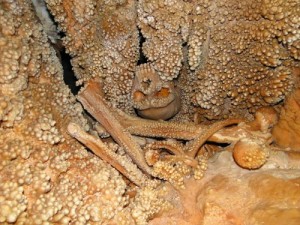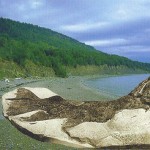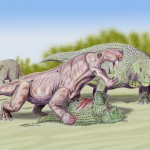During the age of the mammoth, a hominin roaming southern Italy stumbled into a hole in the karst landscape. Out of reach of sun and predator, he starved to death, his body decaying and his bones slumping into a pile, mineral-rich waters ultimately calcifying and fusing them into the surrounding limestone. Locked in the limestone, his skeleton would remain there until 1993, when cave explorers found his face--upside down--staring back at them.

The Neanderthal in the karst: at 150,000 years old, this Neanderthal is the oldest from which endogenous DNA has been extracted. Image credit: Lari et al. 2015.
Since extracting the deeply embedded bones would destroy them, technical and ethical considerations prevented the removal of the skeleton for detailed analyses, limiting studies to documented on-site observations. While the brow ridges, mastoids, and cranial vault identified the hapless Pleistocene wanderer as a Neanderthal, without lab work (the first dating attempts were foiled by the calcite overgrowths), his age remained a mystery--until researchers retrieved a piece of the right scapula (shoulder blade), covered by only a superficial calcite film.
Dating of the scapula, combined with new and previous U/Th analyses of the calcite, placed the Neanderthal's death in the range of 150,000 years ago--making him the oldest Neanderthal from which endogenous DNA has been extracted. His species would outlive him for another 110,000 years, having fallen extinct 40,000 years ago.
Lari, M., Di Vincenzo, F., Borsato, A., Ghirotto, S., Micheli, M., Balsamo, C., ... & Manzi, G. (2015). The Neanderthal in the karst: First dating, morphometric, and paleogenetic data on the fossil skeleton from Altamura (Italy). Journal of Human Evolution. doi: 10.1016/j.jhevol.2015.02.007






